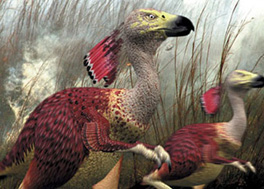Carakiller
From Saecula Novae
The carakiller is descended from the crested caracara and is quite similar to the terror birds (family Phorusrhacidae) of the early Cenozoic era. They have retained two large claws, one on each forelimb, much similar to the prehistoric terror bird Titanis. Around ten feet (three meters) tall, they are the largest predatory birds since the terror birds died out two million years ago, and are among the largest of all avian species.
Carakillers specialize in quick movements and hunt in packs. They commonly stroll along the outskirts of grasslands that have been set on fire, and kill any animal found struggling to escape the fire, similar to what storks do today by feeding on the fire edge. Carakillers can communicate by moving the feathers on the top of their heads. The carakillers main source of food is the babookari, although they will attempt to eat almost any animal and can easily kill any aside from the rattleback.
|
|||||||||


